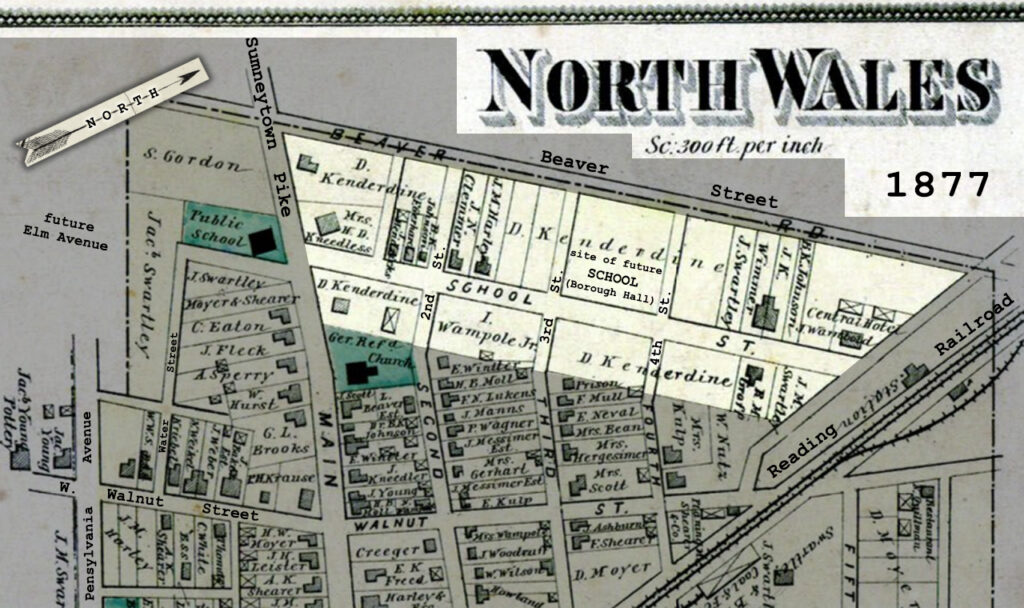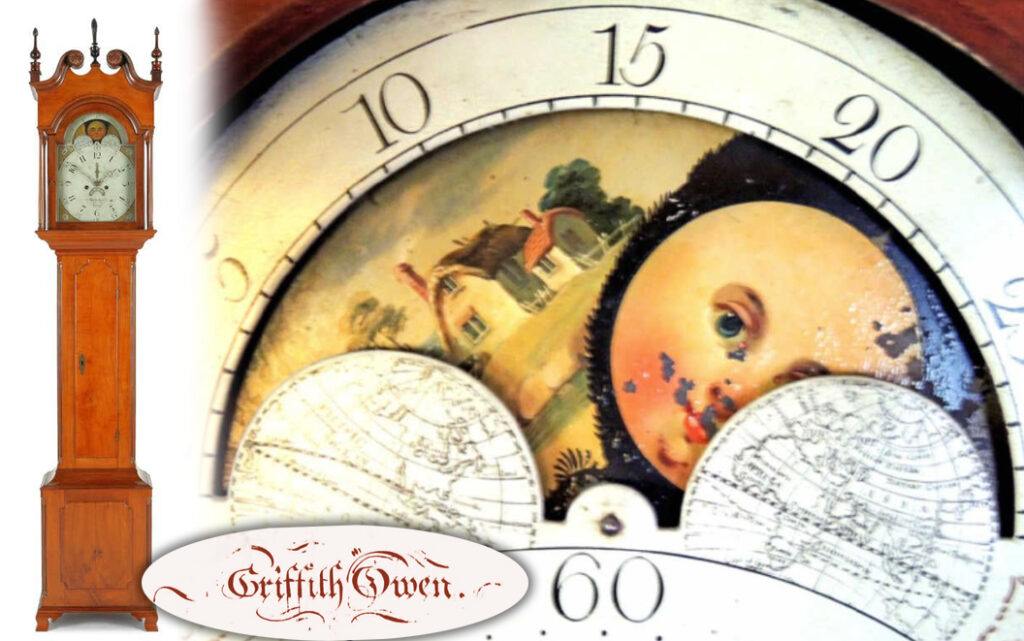We will now take up the Kenderdine property which occupied a considerable portion of the present borough of North Wales, now covered by streets and houses. It was a strip of twenty acres, extending from Main street along School street northwest to beyond the railroad station.
On this tract stood Amusement Hall, the public school building which is still standing [now borough hall], the Central Hotel [apartment building at 428 School St.], the railroad station and many dwellings. On a large lot bordering School, Main and Second there stood a brick dwelling. Up to this time, Daniel Kenderdine had been a successive owner. A building probably stood here many years before the Revolution. A convenient spring of water was close at hand.
In shape, this tract was 452 feet wide on Main street, 2485 feet (nearly half a mile) in length, but only 396 feet wide at the northeast end.
In the beginning about one half of this tract was covered by the grant of 720 acres to Robert John in 1702, and by him conveyed by a will in 1732 to his son John. The upper side, next to the former Beaver farm, was part of the Evan Pugh patent of 1048 acres. Of the latter 185 acres had been bought by Cadwallader Foulke, by Robert John and which John Jones also received by will.

After nearly a quarter of a century, John Jones began to break up his inherited estate. In 1755 he sold 108 acres including half of this to David Cummings. in 1788 Jones sold 158 acres to Abraham Lukens, and in the same year the latter sold 80 acres of it, upon which was a dwelling to his son, Abraham Lukens, Jr. Within this was the other ten acres.
In 1760 Cummings sold to George Morris. Morris was a speculator and only two years later, sold to Mathias Lukens. In 1764 the latter conveyed to Joseph Lukens ten acres. He had bought the other ten acres in 1762 of Abraham Lukens. Thus in 1762 the twenty acres first became a consolidated property, and would continue as such for over 100 years.
Ten years later, in 1772, Job Lukens bought the house and twenty acres.
Job Lukens was the owner during the American War of Independence, holding the property for fourteen years, during which troublesome times he was busy making saddles. In those days when there were few wheeled vehicles, this was the main work of the harness maker, for the horse was a widely used means of transportation.
Then in 1786 along came a weaver from Solebury, Bucks county. He had an English Quaker name, common in that county, but then unknown in Montgomery. This was John Hampton, who gave 200 pounds, or $1000, for the little house and lot. There he worked his loom for six years. At that time the following were the adjoining land owners: Jonathon Clayton was on the upperside, Isaac Kulp, Abraham Lukens. The latter had ownership at the southeast side. The name of John Hampton is found in the list of Gwynedd Taxpayers for 1792.
In 1792 John Hampton sold to Ezra Thomas for twenty pounds less than he gave or 180 pounds. Thomas was the owner four years and then sold to another Welshman in 1796, who was Griffith Owen. Owen was a famous clock maker and those tall old fashioned clocks came from his hands, now known as “Grandfather Clocks.”

At that time Jacob Dilcart owned the Main street tavern property together with a farm of 72 acres. It was no tavern then. It appears that Owen wished to obtain a spot from which flowed a spring, instead of carrying water from the spring of a near neighbor. So in 1803 Dilcart sold him a tract of land comprising ten perches for twenty dollars. In the same year Owen sold the whole property to another Welshman bearing his own first name for his last name. This was Doctor Amos Griffith. The latter was the son of Griffith Griffiths and was born in East Nantmeal, Chester county, in 1770. He gave 375 pounds for the property, or about $1800.
Griffiths ownership of this property lasted thirty-four years, or until 1837, when he sold to Anthony Barnhart. The latter was a wheelwright and worked in a shop which stood near the old house. in 1848 he sold the property to Daniel Kenderdine for $1300. The latter lived there for twenty-seven years and died in October 1875. From time to time portions of the original twenty acres were sold off for building lots [along School Street]. The remainder was long owned by the widow, Mrs. Lavina Kenderdine.
Mrs. Kenderdine died previous to 1896. In 1902 her executors sold the old house and lot where she had lived, to the North Wales Building and Loan Association for $3500. Since then the old house was torn down and two double brick houses built on the lot. These are the houses facing Main Street between School street and the Reformed Church [St. Luke’s]. The twenty acres once held by Mrs. Kenderdine had previously been lessened by the sale of several lots to various individuals, and to the North Wales School District. [The school district purchased eight lots, comprising the entire block bounded by 3rd and 4th Streets, School and Beaver Streets.]
Our next installment will discuss the Zebley farm and its connection with the borough.
This post is sourced from a column entitled Early North Wales: Its History and Its People penned by long-time North Wales resident historian Leon T. Lewis. The article appeared in its original form in the March 31, 1959 issue of the North Penn Reporter.
